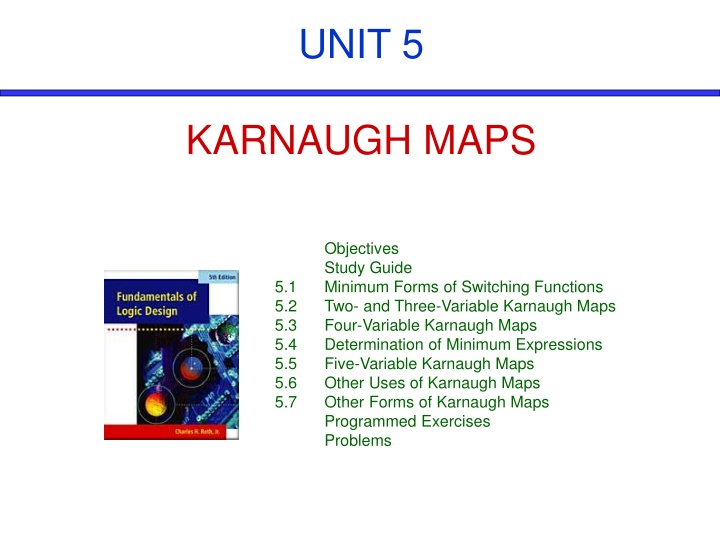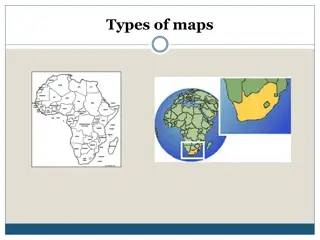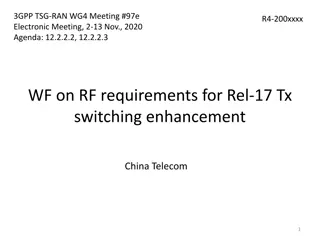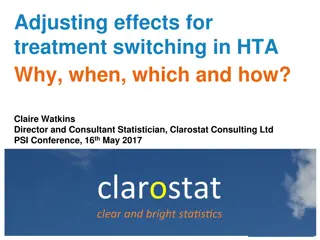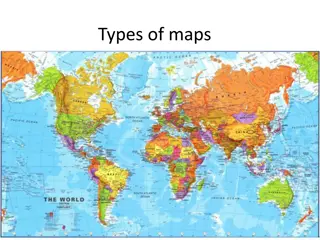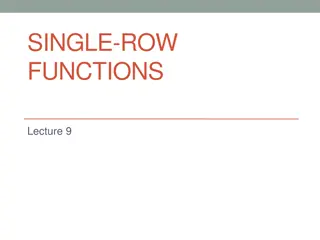Mastering Karnaugh Maps for Switching Functions
Dive into the realm of Karnaugh Maps to plot, simplify, and optimize switching functions with ease. Explore minimum forms, essential prime implicants, and algebraic techniques to streamline your logic circuit designs.
Download Presentation

Please find below an Image/Link to download the presentation.
The content on the website is provided AS IS for your information and personal use only. It may not be sold, licensed, or shared on other websites without obtaining consent from the author.If you encounter any issues during the download, it is possible that the publisher has removed the file from their server.
You are allowed to download the files provided on this website for personal or commercial use, subject to the condition that they are used lawfully. All files are the property of their respective owners.
The content on the website is provided AS IS for your information and personal use only. It may not be sold, licensed, or shared on other websites without obtaining consent from the author.
E N D
Presentation Transcript
UNIT 5 KARNAUGH MAPS Objectives Study Guide Minimum Forms of Switching Functions Two- and Three-Variable Karnaugh Maps Four-Variable Karnaugh Maps Determination of Minimum Expressions Five-Variable Karnaugh Maps Other Uses of Karnaugh Maps Other Forms of Karnaugh Maps Programmed Exercises Problems 5.1 5.2 5.3 5.4 5.5 5.6 5.7
Objectives 1. Given a function (completely or in completely specified) of three to five variable, plot it on a Karnaugh map. The function may be given in minterm, maxterm, or algebraic form. 2. Determine the essential prime implicants of a function from a map. 3. Obtain the minimum sum-of-products or minimum product-of- sums form of a function from the map. 4. Determine all of the prime implicants of a function from a map. 5. Understand the relation between operations performed using the map and the corresponding algebraic operation.
Karnaugh Maps Two Problems of Simplifying a Switching Function Using Algebraic Techniques 1. Difficult to apply in a systematic way. 2. Difficult to tell when you have arrived at a minimum solution. Karnaugh Map method and Quine-McCluskey Procdure Easy and systematic to get a a minimum solution.
5.1 Minimum Forms of Switching Functions Realizing a switching function using AND and OR gates C C D D E E CD + + ' ' ' AB E AC E + + A A C' C' E E Sum-of-Products form
5.1 Minimum Forms of Switching Functions C C D D E E CD + + ' ' ' AB E AC E + + A A C' C' E E Sum-of-Products form What we want is a circuit with Minimum number of gates Minimum number of terms Minimum number of gate inputs Minimum number of literals Minimum Sum-of-Products form
5.1 Minimum Forms of Switching Functions Procedure for obtaining a minimum sum-of-products + ' = 1. Combine terms by using . Do this repeatedly to eliminates as many literals as possible. XY XY X + = X X X A given term may be used more than once because 2. Eliminate redundant terms by using the consensus theorem or other theorems.
5.1 Minimum Forms of Switching Functions = ( , , ) ) 7 , 6 , 5 , 2 , 1 , 0 ( m F a b c Example: Find a minimum sum-of-products = + + + + + ' ' ' ' ' ' ' ' ' F a b c a b c a bc ab c abc abc = + + + ' ' ' ' a b b c bc ab = + + + + + ' ' ' ' ' ' ' ' ' F a b c a b c a bc ab c abc abc = + + ' ' ' a b bc ac The result may depend on the order in which terms are combined or eliminated
5.1 Minimum Forms of Switching Functions Example: Find a minimum product-of-sums dual + ' = + + = ( ' )( ) X Y X Y X XY XY X + + + + + + + + + + + + + + + + + + ( ' ( ) ' D ' ' ( ) ' D ' ' ( ) ' ' ' ( ) ' ( ) ' ' ) A B C A B C A B C D A B C D A B C D A B C D ( = + + + + + + + + ' ) ' D ( ' ) ' C ( ' ' ) ( ' ) A B A B B C D B C D ( = + + + + + ' ) ' D ( ' ) ' C ( ' ) A B A B C D ( = + + + ' ( ) ' D ' ) A B C D Eliminated by consensus
5.2 Two- and Three-Variable Karnaugh Maps A 2-variable Karnaugh Map
5.2 Two- and Three-Variable Karnaugh Maps Example: Truth table and Karnaugh map for a two-variable function A B F 0 0 0 1 1 0 1 1 1 1 0 0 (a)
5.2 Two- and Three-Variable Karnaugh Maps Example: Truth table and Karnaugh map for a three-variable function A B C 0 0 0 0 0 1 0 1 0 0 1 1 1 0 0 1 0 1 1 1 0 1 1 1 F 0 0 1 1 1 0 1 0 (a)
5.2 Two- and Three-Variable Karnaugh Maps Location of minterms on a three-variable Karnaugh map Minterms in adjacent squares differ in only one variable Can be combined using the theorem + ' = XY XY X
5.2 Two- and Three-Variable Karnaugh Maps Plot of minterms and maxterms = + + = = ( , , ) ) 5 , 3 , 1 ( m ) 7 , 6 , 4 , 2 , 0 ( M F a b c m m m Karnaugh Map of 1 3 5 Plot of minterm: mark 1 Plot of maxterm: mark 0 = + + ( , , ) F a b c m m m 1 3 M 5 = M M M M 0 2 4 6 7
5.2 Two- and Three-Variable Karnaugh Maps Karnaugh maps for non-minterm product terms term b term bc term ac
5.2 Two- and Three-Variable Karnaugh Maps Karnaugh maps for non-minterm product terms = + + ( , , ) ' ' ' f a b c abc b c a
5.2 Two- and Three-Variable Karnaugh Maps Simplification of a Three-Variable Function ? ?,?,? = ?(1,3,5) ? = ?1+ ?2= ? ? + ? ?
5.2 Two- and Three-Variable Karnaugh Maps = ) 5 , 3 , 1 ( m F Complement of a function F : Replace 0 1 and 1 0 ? = ?1+ ?2= ? + ??
5.2 Two- and Three-Variable Karnaugh Maps Karnaugh map for consensus theorem Consensus term is redundant
5.2 Two- and Three-Variable Karnaugh Maps Function with two minimum forms ?(?,?,?) = ?(0,1,2,5,6,7)
5.3 Four-Variable Karnaugh Maps Location of minterms on four-variable Karnaugh map
5.3 Four-Variable Karnaugh Maps Plot of a function ? ?,?,?,? = ??? + ? ? + ?
5.3 Four-Variable Karnaugh Maps Simplification of four-variable function
5.3 Four-Variable Karnaugh Maps Simplification of four-variable function
5.3 Four-Variable Karnaugh Maps Simplification of an function with don t care conditions don t care term
5.3 Four-Variable Karnaugh Maps Find minimum product-of-sums by using Karnaugh map + + = Given + ' ' ' ' ' ' f x z wyz w y z x y Plot 1 s of f Group 0 s in the map f = + + ' ' ' ' f y z wxz w xy Apply DeMorgan s law = + + + + ( ' )( ' ' )( ' ) ' y f y z w x z w x
5.4 Determination of Minimum Expressions Using Essential Prime Implicants Implicants of F Any product term in sum-of products form Prime Implicants of F A product term which can not be combined with other terms to eliminate variable Prime Implicants Non-Prime Implicants
5.4 Determination of Minimum Expressions Using Essential Prime Implicants Determination of Prime Implicants (PI) A single 1 on a map can be a PI if it is not adjacent to any other 1 s. Two adjacent 1 s if they are not contained in a group of four 1 s. Four adjacent 1 s if they are not contained in a group of eight 1 s. And so on Prime Implicants Non-Prime Implicants
5.4 Determination of Minimum Expressions Using Essential Prime Implicants Prime Implicants and Minimum Solution ab
5.4 Determination of Minimum Expressions Using Essential Prime Implicants Systematic Procedure for Selecting Prime Implicants CD is chosen first Other PI s are chosen first
5.4 Determination of Minimum Expressions Using Essential Prime Implicants Essential Prime Implicants (EPI) If a minterm is covered by only one PI, the PI is said to be an EPI m5 m14 BD, B C, AC: EPI m2
5.4 Determination of Minimum Expressions Using Essential Prime Implicants Procedure for Selecting EPI 1. Loop all PI BC AB CD 01 11 10 00 2. Find minterm covered by only one PI 00 1 1 0 4 12 8 3. Select that PI as an EPI 1 1 1 01 1 5 9 13 4. Repeat step 2 and 3 1 1 1 11 3 7 15 11 1 1 1. m4is covered by only BC 2. m10is covered by only AC 3. BC and AC are EPI 10 2 6 10 14 AC
5.4 Determination of Minimum Expressions Using Essential Prime Implicants Systematic Approach for Finding EPIs If a given minterm and all of the 1 s adjacent to it are covered by a single term, then that term is an EPI. If all of the 1 s adjacent to a given minterm are not covered by a single term, then there are two or more PIs which cover that minterm, and we cannot say whether these PIs are essential or not without checking other minterms.
5.4 Determination of Minimum Expressions Using Essential Prime Implicants Systematic Approach for Finding EPIs 1. Check adjacent 1 s for m0(10) No single term covers 10, 11, 12, 14. No EPIs AB CD 01 11 10 00 00 2. Check adjacent 1 s for 11 A C covers 11, 10, 15. A C is an EPI. 1 1 0 4 12 8 A C 01 1 1 1 5 9 13 11 1 1 1 3. Check adjacent 1 s for 12 A B D covers 12, 10. A B D is an EPI. 3 7 15 11 10 1 2 6 10 14 A B D
5.4 Determination of Minimum Expressions Using Essential Prime Implicants Systematic Approach for Finding EPIs 4. Check adjacent 1 s for 17 No single term covers 17, 15, 115. No EPIs AB CD 01 11 10 00 00 5. Check adjacent 1 s for 111 ACD covers 11, 10, 15. ACD is an EPI. 1 1 0 4 12 8 A C 01 1 1 1 5 9 13 11 1 1 1 6. A BD or BCD is selected to include 17. 3 7 15 11 A BD 10 1 2 6 10 14 + ' A BD or + + ' ' ' ' A C A B D ACD BCD ACD A B D BCD
5.4 Determination of Minimum Expressions Using Essential Prime Implicants Flowchart for Determining a Minimum SOP Using a Karnaugh Map Choose a 1 which has not been covered. NO All uncovered 1 s checked? Find all adjacent 1 s and X s. YES Are the chosen 1 and its adjacent 1 s and X s covered by a single term? NO Find a minimum set of prime implicants which cover the remaining 1 s on the map. YES That term is an EPI. Loop it. Stop.
5.4 Determination of Minimum Expressions Using Essential Prime Implicants A B covers 16and its adjacent EPI AB D covers 110and its adjacent EPI AC D is chosen for minimal cover AC D is not an EPI AB CD 01 11 10 00 00 X0 14 18 15 113 19 01 AC D 11 X7 X15 A B 16 110 10 AB D
5.5 Five-Variable Karnaugh Maps Two Layers of Four-Variable Karnaugh Map
5.5 Five-Variable Karnaugh Maps Five Adjacent Terms Four adjacent terms in the same layer One adjacent term in the other layer
5.5 Five-Variable Karnaugh Maps = ( , , , , ) , 5 , 4 , 1 , 0 ( m 13 15 , , 20 , 21 , 22 23 , 24 , , 26 , 28 30 , 31 , ) F A B C D E Resulting minimum solution F = D B ABE + ACD + A + BCE ' AB C + ' ' ' ' ' B or CD A ' ' P P P P 1 2 3 4
5.5 Five-Variable Karnaugh Maps = ( , , , , ) , 9 , 8 , 3 , 1 , 0 ( m 14 15 , 16 , 17 , 19 , , 25 27 , 31 , ) F A B C D E Final solution + = + ' ' C or D E + + + ' ' ' ' ' ' ' ' ' F B C D B C E A C D A BCD 4 ABDE 5 ' ' P P P P P A C E 1 2 3
5.6 Other Uses of Karnaugh Maps Finding Common Terms
5.6 Other Uses of Karnaugh Maps A Guide for Simplifying a Function Algebraically + = + + ' ' ' ' F ABCD B CDE A B BCE 1. Add the term ACDE Using 2. the consensus theorem : = + + + ' + ' ' ' F ABCD B CDE A B BCE ACDE Minimum 3. solution : = + ' + ' ' F A B BCE ACDE ACDE
5.7 Other Forms of Karnaugh Maps Veitch Diagrams
5.7 Other Forms of Karnaugh Maps Other Forms of Five-Variable Karnaugh Maps
